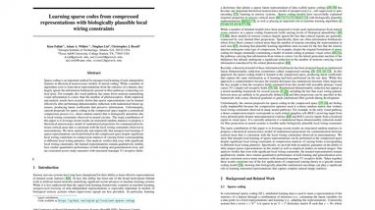Learning sparse codes from compressed representations with biologically plausible local wiring constraints

Sparse coding is an important method for unsupervised learning of task-independent features in theoretical neuroscience models of neural coding. While a number of algorithms exist to learn these representations from the statistics of a dataset, they largely ignore the information bottlenecks present in fiber pathways connecting cortical areas...
For example, the visual pathway has many fewer neurons transmitting visual information to cortex than the number of photoreceptors. Both empirical and analytic results have recently shown that sparse representations can be learned effectively after performing dimensionality reduction with randomized linear operators, producing latent coefficients that preserve information.